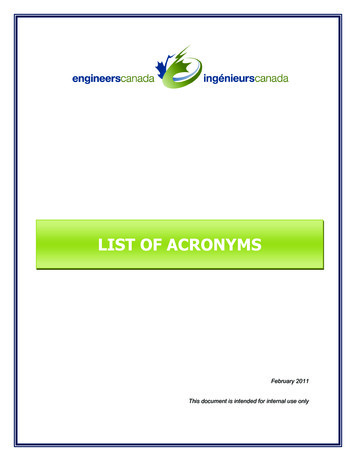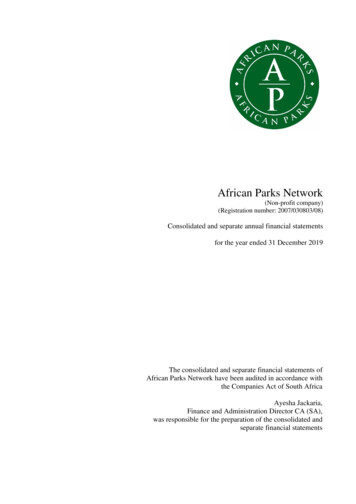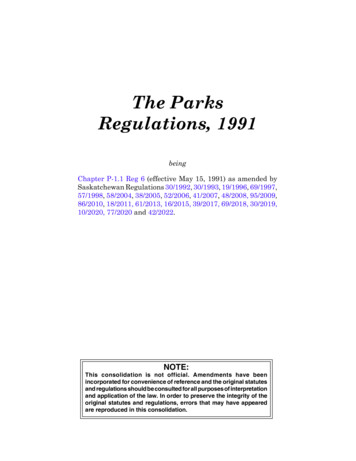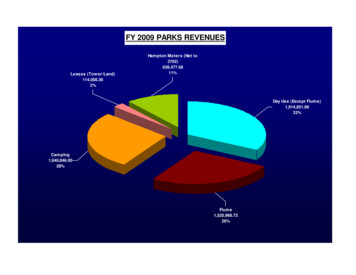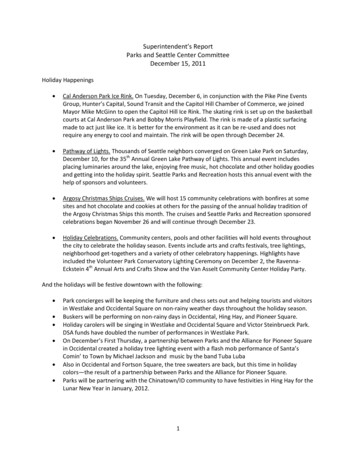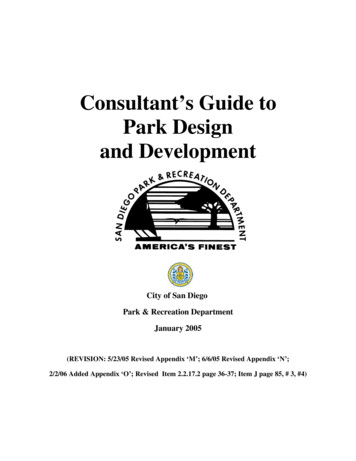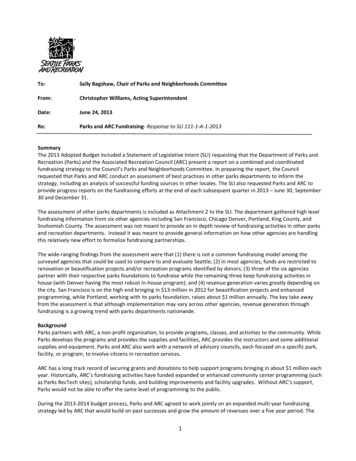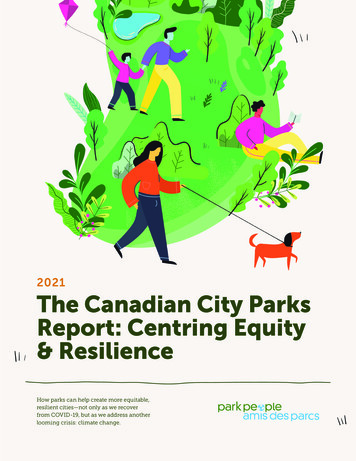
Transcription
2021The Canadian City ParksReport: Centring Equity& ResilienceHow parks can help create more equitable,resilient cities—not only as we recoverfrom COVID-19, but as we address anotherlooming crisis: climate change.
FUNDER FOREWORDCanadians continue to face thechallenges of COVID-19 as we livethrough year two of this global crisis.Throughout the pandemic, city parkshave played an integral role in providingrelief by offering green spaces forcommunity members to exercise,socialize and reap the benefits of nature.Three years ago, our Foundation supported ParkPeople to fill an information gap by gathering,analyzing and sharing data and stories aboutCanada’s city parks system. Since that time,the annual Canadian City Parks Report hasbecome an invaluable tool for municipal staffand volunteers to highlight challenges and sharebest practices with their peers across Canada.This year’s Canadian City Parks Report providesan in-depth look at how parks can help buildrobust and resilient cities, especially in timesof crisis. To inform the report, Park Peopleconducted an online survey garnering nearly3,500 responses. Canadians clearly have alot to say about their city parks. The resultsof the survey show the undeniable benefitsof park environments for the physical andmental well-being of community members.The 2021 report also focuses on the crisis ofclimate change and the role parks can play incombatting it. It illuminates the importanceof climate-resilient infrastructure to mitigatethe effects of a changing climate such asfloods, extreme heat and loss of biodiversity.A chapter on climate justice highlights thedisparity in access to green spaces in differentcommunities and how some cities are leadingthe charge to address these inequities.Thank you to the team at Park People for creatingthis annual snapshot of the state of Canada’s cityparks. Our Foundation is honoured to supportthis vital resource, and we are grateful to workwith an organization that drives innovationand improvement in Canada’s urban parks.We would also like to thank the countlessmunicipal staff in towns and cities acrossCanada who have helped bring this report tolife through their contributions of data, storiesand experiences. It is because of their tirelesswork that our parks have continued to offer arespite throughout these unprecedented times.Reading through this year’s report, I am hopefulfor the future as we see the important workbeing done to create equitable communities,combat climate change and increase residents’connection to nature in city parks across Canada.These efforts are vital to maintain and improvethe health of our natural ecosystems and, inturn, support the well-being of all Canadians.EMMA ADAMO - CHAIRWESTON FAMILY FOUNDATION2
CONTENTSStart HereCity Profiles 49British Columbia 50Executive Summary 4Acknowledgements 10Alberta 71Introduction 11Saskatchewan 77Lessons from a pandemic year 13Manitoba 862021 Trends, Challenges& Covid-19 Impacts Ontario 8922Quebec 122New Brunswick 137Nova Scotia 140Prince Edward Island 143Next Steps 146About Us 147SectionsNature 25Inclusion 30Growth 33Collaboration 38Activation 42Methodology 46Definitions 473
EXECUTIVE SUMMARYIn Park People’s third annual CanadianCity Parks Report, we focus on howparks can foster more resilient, equitablecities—not only as we recover fromCOVID-19, but as we address anotherlooming crisis: climate change.Park use during the pandemic spikedacross the country as people floodedinto outdoor spaces to seek safe ways toconnect with others, experience nature,and get some exercise. Parks becamemore important to Canadians in theirdaily lives, but cities also faced newchallenges with rising demands andpublic health considerations.The Canadian City Parks Report documentsthese trends and challenges by gathering key dataand leading practices from across the country.Whether you’re city staff, a community volunteer,a funder, a non-profit organization, a parkprofessional, or a resident who loves city parks,we hope this report provides you with useful dataand stories that both inspire and challenge you.In this report you’ll find the results of our April2021 COVID-19 and Parks survey of nearly3,500 Canadians, interviews with a range ofexperts, as well as new data and practices from32 participating Canadian cities. Stories and dataare organized by section—Nature, Inclusion,Growth, Collaboration, and Activation—andcity-specific data is available in City Profiles.E xecuti v e S umma ryAmong others, you’ll find stories and actionabletake-aways on how cities can advance climateaction through parks, how Black and Indigenousleadership can help reframe notions of parkstewardship, and how we can deepen theintersection of public health and parks bytaking into account cultural experiences.You’ll also find a special section: LessonsFrom a Pandemic Year. This section divesdeep into the ways COVID-19 impacted ourpark systems and our use of parks during thelast year—both positive and negative—andthe ways we can move forward together.THERE ARE T WO WAYS TO READ THISREPORT.It is available as an interactive website and as adownloadable PDF. The COVID-19 lessons, keyinsights, take-aways, and city data are includedboth online and in a downloadable PDF format.The stories—which share leading practicesand interviews with city staff, researchers, andcommunity leaders—are available exclusivelyon the website: cityparksreport.parkpeople.ca.4
EXECUTIVE SUMMARY / KEY INSIGHTSParks saw high use andshowed high value.*94% of cities reported increased use ofparks in the last year: This elevated usemay stick around with 82% of Canadianswho indicated using parks more duringthe pandemic saying they expect theircurrent use to continue or increase.*Parks were also used more in thewinter: with 50% of Canadians sayingthey had used parks more during winterthan pre-pandemic, and 73% expectedthis use to continue.*Of all park types, Canadians say theyprefer to visit: local neighbourhoodparks (71%), natural areas (61%) and trails(60%), reflecting the importance of nearbygreen spaces.*Community park groups continued toanimate their local parks: with nearly300 groups across the country puttingon over 3,600 events—half of which werevirtual.E xecuti v e S umma ry5
EXECUTIVE SUMMARY / KEY INSIGHTSNew challenges broughtnew ways of using parks.*City staff moved quickly to addressthe pandemic: 84% instituted COVID-19related pilots, such as temporarywashrooms, one-way trails to ensurephysical distancing, and keeping seasonalrecreational facilities, like tennis courts,open into the winter.*Measures that Canadians wouldmost like to see permanent: includewinterized washrooms (57%), outdoorcafes (55%), and outdoor arts/cultureevents (53%).*Cities creatively implemented thesenew measures, and responded tothe challenges of high park use,all while grappling with increasedbudget pressures: 60% of cities reportedCOVID-19 had negatively impacted parksoperating budgets.*Canadians want to see their parksfunded well: 85% said they would liketo see more public funding of parkssplit between maintenance (43%), newamenities and higher quality designs(27%), and community programming(23%).E xecuti v e S umma ry6
EXECUTIVE SUMMARY / KEY INSIGHTSParks were recognizedas critical public healthinfrastructure.*Increased park use reflected thebenefits Canadians get from parks:with nearly two thirds saying theirappreciation of parks had increasedduring the pandemic, particularly formental health (85%), physical health (81%),and social connection (71%).*60% of cities said that COVID-19 hadincreased attention on parks as publichealth infrastructure: with 89% of thosecities saying they believed this would be along-term trend.*The pandemic also catalyzed newpartnerships: with 84% of cities reportingincreased collaboration between parksand other departments such as publichealth.E xecuti v e S umma ry7
EXECUTIVE SUMMARY / KEY INSIGHTSThe equity gap wasmade clearer.*The work of community advocates waskey in highlighting inequities withinparks and public spaces: such as accessand safety, bringing attention to theseissues throughout the pandemic.*Cities are tuning into the impactsof systemic inequities anddiscrimination: with 43% reporting thataddressing these issues was a challenge—roughly the same percentage alsoindicated the pandemic had increasedattention on these issues.*Canadians who identified as Black,Indigenous, or a person of colour weremore likely to report experiencingbarriers to park use during thepandemic: such as fear of ticketing (24%)and harassment (22%). Despite this, theywere more likely to cite an increasedinterest in stewardship activities (70%)than white Canadians (54%).*Canadians are thoughtful abouthow people may engage with parksdifferently from them: with 77%agreeing that aspects of people’s identity(e.g., race, gender, age) affect how aperson experiences parks.E xecuti v e S umma ry8
EXECUTIVE SUMMARY / KEY INSIGHTSClimate action throughparks is a growingpriority.*While COVID-19 consumed attentionin 2020, the climate crisis is also apriority: 84% of cities reported dealingwith climate change impacts and extremeweather as a challenge.*Cities are moving on this, however:72% of cities reported having a climateaction plan in place. This is a rise over lastyear, attributable to both the inclusion ofadditional cities in the 2021 report andrecently approved climate action plans.*Climate change is also on the mindsof park users: 92% of Canadians saidthey would support climate-resilientinfrastructure built into parks.E xecuti v e S umma ry9
ACKNOWLEDGEMENTSA report this size is a team effort.First, huge thanks to the dozens of citystaff that worked with us to compile citydata, answer our questions, and respondto interview requests. We know this takesa tremendous amount of work and thisreport is not possible without you.We’d also like to thank the parks professionals,community members, non-profit staff, and academicresearchers who provided their time and expertise,including Alanah Jewell, Alina Chatterjee, AnnePelletier, Carmen Rosen, Chad Townsend, ChúkOdenigbo, Doug Bennet, Dylan Rawlyk, Eli Enns, Dr.Fikile Nxumalo, Florence Lecours-Cyr, GenevièveBédard, Heather Douglas, Jacqueline L. Scott, Dr.Janelle Joseph, Josh Shea, Katherine Howard, LarissaCrawford, Leya Barry, Lourdenie Jean, Manon Otto,Marica Vazquez Tagliero, Marisol Narvaez, MaryFarrar, Dr. Melissa Lem, Michael Polanyi, NadhaHassen, Dr. Naomi Adiv, Nico Bernard, NoémieBélanger, Patricia Collerette, Pina Mallozzi, RudaynaBahubeshi, Shannon Baker, Sheila Boudreau,Sheila Taylor, Sherry Yano, Simon O’Byrne, SusanHoldsworth, Travis Canadien, and Yvonne Yeung.In-House Experts and Reviewers:Brianna Aspinall, Minaz Asani-Kanji, SeanBrathwaite, Rachel Yanchyshyn, Natalie Brown,Dave Harvey, Marie Lapointe, Sue Arndt, ErikaNikolaiDesign:HypenoticWe would like to extend a heartfelt thanks to theWeston Family Foundation for their leadershipin supporting the creation of this report in 2019and its publication for the last three years.We would also like to thank the RBC Foundation, TorontoFoundation, Maglin Site Furniture, and an anonymousdonor for their support.Authors:Adri Stark, Jake Tobin Garrett, Nahomi AmberberResearch and COVID-19 Survey Development:Stephanie StanovQuebec Liaisons and Research Support:Caroline Magar, Marie-Hélène Roch, TimopheiKirpichnikovData Management:Eliesha RichardsonLastly, but not least, thank you to the entire ParkPeople team for their support and input.Sponsor and Partnership Development:Jodi Lastman, Michelle CuttsFrench Translation:Jennifer OcquidantCommunications and Translation Review:Clémence MarcastelAc knowledgements10
INTRODUCTIONLast year was tough.But it was alsoilluminating.We know from city staff andour survey of the Canadianpublic that park use duringthe COVID-19 pandemic hasincreased significantly incities all over Canada.In this respect, COVID-19has shown how parks bolstercommunity resilience byproviding a place for peopleto stay active, de-stressand connect with others—safely. For many, parkshave become a lifeline.This shows in the numbers.Two-thirds of the nearly3,500 Canadians Park Peoplesurveyed in April 2021 saidtheir appreciation of parkshad increased during thepandemic. People flockedto their local parks, soughtout natural areas, took moreregular walks along trails, andtried new winter activities.This greater appreciation hasimportant health benefits: 85%of Canadians said parks had apositive impact on their mentalhealth, 81% on their physicalhealth, and 71% on their senseof social connection duringthe pandemic—critical inaddressing the isolation so manyhave felt during the last year.But COVID-19 has alsoshown there is work to do inaddressing inequities anddiscrimination—particularlyaround homelessness inparks and anti-Black andanti-Indigenous racism.Our survey of Canadians foundthat people who identifiedas Black, Indigenous or aperson of colour were morelikely to report experiencingbarriers to park use, includingconcerns about ticketing, socialjudgement, and harassment.Additionally, 90% of citiesreported homelessness inparks as a challenge, asignificant rise from last year.Park Circles, Toronto. Credit: Steve Russell, Toronto Star via Getty ImagesI ntr odu c tion11
Addressing these inequitiesis essential in movingtowards parks where morepeople feel safe and seethemselves reflected.In the third annual CanadianCity Parks Report, we focuson how parks can fostermore resilient, equitablecities—not only as we recoverfrom COVID-19, but as weaddress another loomingcrisis: climate change.loves city parks, we hope thisreport provides you with usefuldata and stories that bothinspire and challenge you.Inside this report you’ll find theresults of our COVID-19 andParks public survey, data andpractices from 32 participatingcities, and interviews withdozens of experts, including citystaff, community leaders, andresearchers. We have used thedata to shape in-depth storiesleadership can help reframenotions of park stewardship,and how we can deepen theintersection of public healthand parks by taking intoaccount cultural experiences.You’ll also find a special section:Lessons From a PandemicYear. This section dives deepinto the ways COVID-19impacted our park systemsand our use of parks duringthe last year—both positive andnegative—and the ways wecan move forward together.Parks alone cannot addressclimate change, racism, andpublic health challenges, but asthe shared spaces in our citiesthey play a vital role in helpingus learn to live together in amore resilient, equitable society.Explore the entire report, includingthe city data, stories, practices,and expert interviews onlineat ccpr.parkpeople.ca/2021.Explore selected sections—including the pandemic lessons,key insights, and city data—ina special downloadable PDF.Beach Volleyball, Kelowna. Credit - Tourism KelownaPark People puts out thisreport to help track the trendsand challenges facing cityparks across Canada. Whetheryou’re city staff, a communityvolunteer, a funder, a nonprofit organization, a parkprofessional, or a resident whoI ntr odu c tionthat reflect what is happeningaround the country and pushforward with new ideas.Among others, you’ll find storiesand actionable take-awayson how cities can advanceclimate action through parks,how Black and Indigenous12
FEATURELessons from apandemic yearWhat COVID-19 taught us abouthow to work towards moreresilient, equitable parks.We can’t talk about 2020without talking aboutCOVID-19. The pandemictouched every part of our lives,highlighting the strengths andweaknesses of our society.The same was true for parks.We saw the increasedimportance of parks for mentaland physical health, but alsotroubling instances of anti-Blackresources, which are archivedon a special COVID-19 resourcepage on Park People’s website.and anti-Asian racism inpublic spaces. We saw howparks helped people stay safelysocially connected, but also howunhoused people were displaced.We saw historic highs in parkusage, but also the strain this puton already tight park budgets.We covered many of thesetopics, and more, in a seriesof webinars we hosted in fall2020, as well as numerousAs we recover from thepandemic, the year ahead will becritical in understanding wherewe go from here. Will park useremain high? Will calls for moreequitable approaches result inaction? Will enhancements likemore winterized washrooms andpedestrianized streets continue?Here we highlight eight lessonsfrom our pandemic year, whichhelped inform the stories inthis year’s Canadian City ParksReport, and point a way forwardto more resilient, equitable cities.Gatineau Park, Gatineau. Credit - Emily CordonierLessons f rom a Pandemi c Y ea r13
Inequities becameimpossible toignoreExperts in Park People’s Urbanism’s Next Chapterwebinar argued that in 2021, we need less talkabout “returning to normal” and more actions thataddress systemic discrimination, the displacementof people experiencing homelessness, andanti-Black and anti-Indigenous racism in ourpark systems, policies and organizations.90%As Canadian placemaker Jay Pitter wrote inthe introduction to Engaging Black Peopleand Power, the 2021 publication she coproduced with York University students and theCanadian Urban Institute: “It’s time to centreBlack place-based expertise and wisdom.”of cities said that addressing homelessnessin parks was a challenge.43%of cities said addressing systemic inequities anddiscrimination was a challenge—roughly thesame percentage also indicated the pandemichad increased attention on these issues.22-24%Canadians who identified as Black,Indigenous, or a person of colour were morelikely to report experiencing barriers to parkuse during the pandemic, such as fear ofticketing (24%) and harassment (22%).We can start by listening to and supportingBlack, Indigenous and people of colour who areleading by reframing our understanding ofpark stewardship. We can also better addresshomelessness and parks through inclusive policiesthat recognize the rights of unhoused parkusers—a topic that we explored in depth in our2020 Canadian City Parks Report and a webinar.Finally, we can develop new equity-basedpolicies to help guide decision-making aboutwhere to make investments and how to betterengage communities, like the ones we profilein our stories on environmental justice,public health, and park philanthropy.If 2020 was anything, it was a bright hot lightexposing the existing inequities in our cities.We often speak about parks as being “for everyone,”but, as many community leaders pointed out, thisobscures the racism, inequitable enforcement,historic underinvestment, unequal access toamenities, and social judgment that exclude manyfrom enjoying and benefitting from green spaces.Community advocates were critical inforegrounding these issues, publishing researchand leading activism that kept media attentionhigh. We saw this in the disproportionateimpact of physical distancing by-laws onBlack, Indigenous and marginalized groups inpublic spaces, in the rising visibility of peopleexperiencing homelessness in parks, andthe increase in anti-Asian racism in Canada(half of which took place in public spaces).“A PARK FOR ALL” Mural on the Don River, Toronto. Credit Evergreen Brickworks, Claire HarvieLessons f rom a Pandemi c Y ea r14
Park budgets werehit from all sidesEven before the pandemic, city park budgets weresqueezed. For the third year in a row, cities reportedinsufficient operating budgets as a key challenge.Shifting demographics, aging infrastructure,rising demand for programs and high qualitydesigns—these were all pressures cities facedpre-pandemic that will only continue to grow.As people spent more time outdoors last year, costsincreased due to higher maintenance needs, newpublic space pilots, and increased staffing in busyparks to ensure public safety. All of these additionalexpenses came as cities saw revenues decreasedue to cancelled park programs and events.The bright spot, however, is the increasedattention on the importance of parks by all levels ofgovernment. In a survey we did in June 2020, 94%of cities said they had seen increased awarenessamong city leadership of the importance of parks.And the Canadian public is highly supportive ofnew investments in parks, with our 2021 surveyshowing that 85% support more public funding.Finally, there is potential for organizationsworking in parks to tap into new fundingsources as part of the COVID-19 recovery,such as the Healthy Communities Initiativelaunched by the federal government in 2021.Busy Riverdale Park East, Toronto. Credit - Jake Tobin Garrett60%of cities said COVID-19 had negativelyimpacted park budgets.85%of Canadians said they want to see morepublic funding invested in parks.Lessons f rom a Pandemi c Y ea r15
Parks were usedmore than ever94%the pandemic (59%) than white Canadians(69%). BIPOC Canadians were also more likely toindicate they spent less time in parks (25%) thanwhite Canadians (17%) during the pandemic,likely related to the increased barriers to accessthat this group reported experiencing.of cities said that park use hadincreased during the pandemic.2/3rdsof Canadians said they had spent more time in parkscompared to pre-pandemic, with 39% reportingtheir park use had doubled during COVID-19.82%of Canadians who said they had spent moretime in parks during the pandemic expecttheir use to continue or even increase.As indoor gatherings were restricted, Canadiansflooded into parks in all weather. We heard thisfrom cities who reported increased use of parksand trails, as well as from Canadians themselves.People using parks is positive, but it also presentschallenges. Cities scrambled to create new bookingsystems for amenities like skating rinks andmanage crowds at suddenly busy splash pads.Community stewardship program participants.Credit - Ontario StreamsMany cities also instituted new rules for jammedtrails, creating one-way systems and trying tokeep people from trampling sensitive naturalareas. Montreal created a Natural EnvironmentProtection committee to put in place awarenessraising measures for sensitive areas.While some of these pressures will ease withreduced physical distancing restrictions in thecoming months, it seems that this high use ofparks will stick around after the pandemic.This increase in park use, however, was not thesame for everyone. Our survey results show thatCanadians who identify as Black, Indigenousor a person of colour (BIPOC) were less likely toreport visiting green spaces more often duringLessons f rom a Pandemi c Y ea r16
Nearby nature wascritical for publichealth83%of Canadians said parks had a positive impact ontheir connection to nature during the pandemic.61%of Canadians said they prefer to visitnaturalized or “wild” parks or greenspaces as well as trails and ravines.58%of Canadians became more interestedin engaging in stewardship activities innatural spaces during the pandemic.As our stress levels rocketed in 2020 andCanadians’ mental health declined, many soughtout more time in nature. Our survey found that85% of Canadians said parks had a positive impacton their mental health during the pandemic.As we wrote about last year, the connectionbetween human well-being and spending time innature has long been established in science. Butnot everyone enjoys access to nature. Perceptionsof safety and unfamiliarity can make people feelwary in natural spaces — a point we explore in ourstories about planning parks for public health.In 2021, we hope to see more focus onneighbourhood greening projects that insertnaturalized spaces where we live our everydaylives — our streets, yards, parks, laneways andschools — perhaps by setting targets for spaceconverted from mowed to naturalized landscapes.Paying attention to informal green spaces beyondparks is important, as 25% of Canadians saidthey visit these kinds of spaces most often.As we document in this year’s report, greeningprojects are key to increasing the climate resiliencyof our communities, reducing flooding andcooling the air. But access to these green spacebenefits is not evenly distributed. We can acton this awareness through new investments,particularly in underserved neighbourhoods.This must include working towardsreconciliation with Indigenous land stewardsby first reckoning with the violent colonialhistory of our parks, as Future AncestorServices Founder Larissa Crawford told us.“Not only are we going to be working towardsthe spirit of restorative relationships and havingbetter relationships with our communities,”she said. “But we’re also going to tap into theplethora of expertise that Indigenous peopleshave, especially with regards to the land andits sustainability, and the ecosystem andour roles as humans in that ecosystem.”A walk through nature. Credit - Jake Tobin GarrettLessons f rom a Pandemi c Y ea r17
Neighbourhoodparks became thestar of the show71%of Canadians said that local or neighbourhood parksare among the types of spaces they prefer to visit.37%of Canadians said lack of amenities suchas washrooms and benches made visitingneighbourhood parks less appealing.The pandemic heightened the importance oflocal parks as places of respite. Indeed, some citiesreported higher use of local parks, and demandfrom residents for new types of all-ages amenitiesfor biking, skateboarding, and adventure play.We know quality neighbourhood parks are notenjoyed equally — and this has real impactson people’s mental and physical health. BIPOCCanadians were less likely to report that parks hada positive impact on their mental and physicalhealth or their sense of social connection duringthe pandemic compared to white Canadians.Outdoor Winter Food Pantry. Credit - MABELLEartsIn 2021, we foresee a renewed focus on qualityneighbourhood parks, including an emphasison providing basic amenities to ensure parksare comfortable and accessible. For exampleCharlottetown said adding more park washroomswas a 2021 priority, Richmond Hill pointedtowards adding more shade structures to parks,and Kelowna noted an interest in rethinkingthe style and arrangement of group seating.But we can go further. Take Richmond, whichexpedited the creation of new communitygardens in parks to address food security.Or how markets for locally produced goodsand food could aid in local economicdevelopment—a key part of the COVID-19recovery as we detail in this year’s report.Lessons f rom a Pandemi c Y ea r18
People engagedin new outdooractivities89%of Canadians said they had tried a new activityin a park in 2020, with top activities includingregular walks through parks and trails (56%) andsocializing with friends and family (40%).76%of Canadians said they want to see morecommunity programming in parks.We hope to see greater support for communitypark programming from cities. This year, justhalf of cities reported having a formal parkgroup program in place and the same amountreported having a policy in place to waivepermit fees due to financial need. The top twoareas park groups said they will need help withwere funding and re-engaging communitymembers to participate in park gatherings.City staff can work with communities and partnerorganizations to provide funding and institutepolicies like simplified permits that allow parkgroups to do more with less paperwork and fees.And rather than relying on signage and punitiveby-law enforcement, cities can instead workwith local leaders and community organizationsto spread information about safe gatheringpractices and collaborate on programming thatgets people back to enjoying the park together.79%of surveyed community park groups saidthat despite a challenging year, their work inparks helped build a sense of belonging.Along with high use, parks also saw an increasein the types of activities people engaged in, asmany did outside what they used to do inside.Cities reported activities such as fitness andart classes, more outdoor eating, and evenhaving a drink in a park. Some cities respondedto these with new policies, such as a by-lawpassed by the City of North Vancouver toallow drinking in certain parks and expansionof park permits to cover more activities.The heart of community programming in manyparks is resident-led initiatives. Many grassrootsgroups struggled in 2020 as COVID-19 restrictedaccess to park amenities and required them tokeep track of fluctuating public health guidelines.Despite these hurdles, 74% of the 273 park groupswe surveyed said they had continued to provide amix of in person and virtual events. This resultedin over 3,600 events (half virtual), put on byover 11,600 volunteers for 125,300 attendees.Lessons f rom a Pandemi c Y ea rMulti-use Path, Kelowna. Credit - Tourism Kelowna19
People got outmore during winterIt’s often said that Canada is a winter nation,and it’s true: for many months of the year ourweather is wet and cold. But people continuedto turn to parks and trails this past winter tokeep active and lessen the winter blues.50%In Regina, the city started a new winter grantprogram to support outdoor communityled programming. Prince Albert saw a 400%increase in downhill skiing and a 250%increase in cross-country skiing over 2019levels. Calgary installed 14 portable fire pits andBrampton expanded its outdoor skating rinks.of Canadians said they had used parks moreduring winter than pre-pandemic with 73%saying they expected this use to continue.51%of Canadians said they wanted to see increasedaccess to winter recreation activities in parks.57%of Canadians said they wanted to seemore winterized washrooms in parks.Washrooms in particular are a critical elementof accessible parks in any season, but especiallyduring COVID-19 when access to privatebusinesses’ washrooms has been restricted. Inresponse to busy winter use, many cities told usthey had stepped up efforts to keep washroomsopen during the winter or add winterized portablewashrooms—an action popu
Canada's city parks system. Since that time, the annual Canadian City Parks Report has become an invaluable tool for municipal staff and volunteers to highlight challenges and share best practices with their peers across Canada. This year's Canadian City Parks Report provides an in-depth look at how parks can help build


